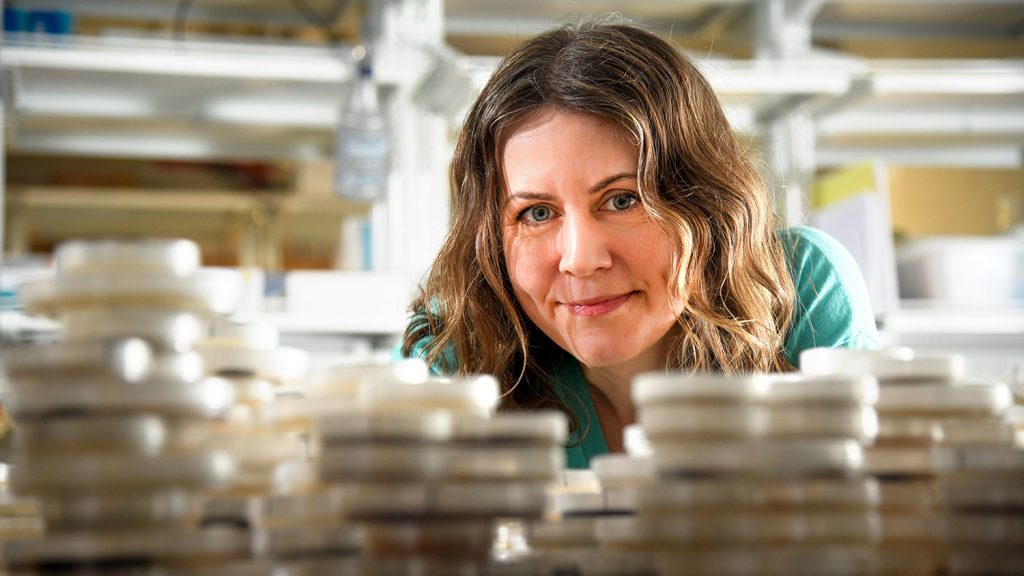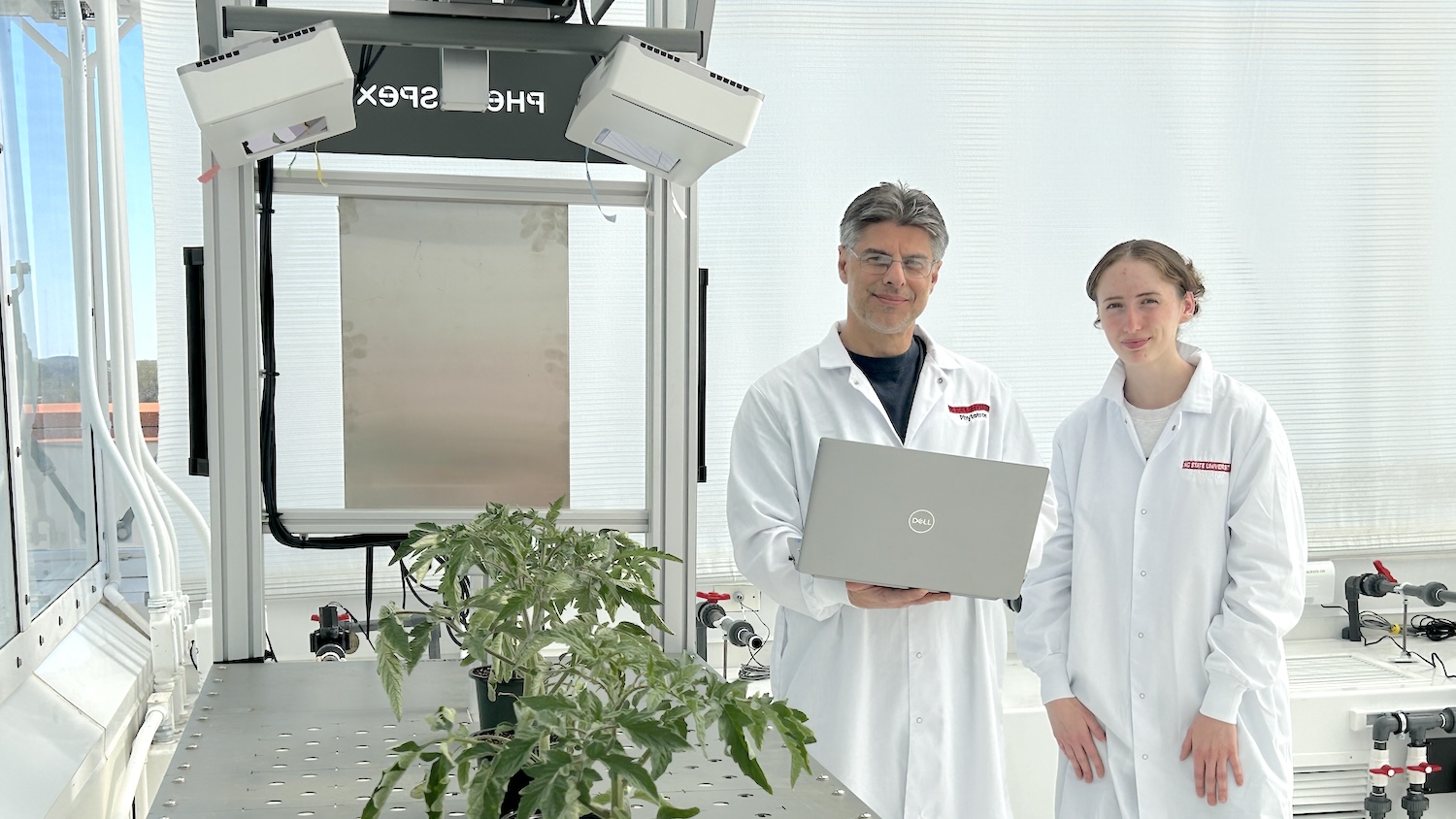Boundary-Crossing Research Paves Way for Fungal Crop Solutions

Think of fungi in agriculture, and you might think first of the crop diseases they cause. But since ancient times, farmers have been using the interactions among fungi and crops to their advantage, often unknowingly. A three-year North Carolina Plant Sciences Initiative project exploring these interactions has helped pave the way to better solutions for drought, plant diseases and other stressors.
Through the FunCrops project, NC State University researchers from six departments in three colleges set out to learn more about the thousands of beneficial fungi found on the leaves of four important crops: corn, soybean, wheat, and switchgrass.
The groundwork they laid could have important implications for making crops more resilient, either by innovating new agricultural products, by developing new farming practices or through breeding or genetic engineering.
Christine Hawkes, a professor in the Department of Plant and Microbial Biology (PMB) and member of the N.C. Plant Sciences Initiative faculty, headed the interdisciplinary FunCrops team.

She sees the plant mycobiome – the community of fungi living on and in plants’ roots, leaves and stems – as the next agricultural science frontier.
“It’s very, very clear that whether a plant tolerates drought or resists pathogens very much depends on the microbiome that inhabits it,” Hawkes said. “We’ve done a lot of work on fungal symbiosis in plants, but not so much on crops — this project gave us the opportunity to better understand their role in agroecosystems.”
A diverse team tackling diverse challenges
The team drew on interdisciplinary expertise not only in biology, but also to develop new research tools and new methods for handling massive amounts of data collected about plant and fungal molecular processes.
Professors Ross Sozzani, of PMB, and Cranos Williams, of the Department of Electrical and Computer Engineering (ECE) and PMB, guided the data efforts, while Professor Mike Kudenov, of ECE, developed a tool to use ultraviolet C light to quickly detect the presence of the fungal disease southern leaf blight in corn fields. “Ideally you’d want to be able to measure the fungus before it creates visible symptoms, but this is really a first step towards that or initial step towards that,” he said.
Associate Professor Kevin Garcia in the Department of Crop and Soil Sciences (CSS) developed molecular tools to genetically manipulate two species of leaf endophytic fungi from switchgrass, a biofuel crop. It was the first time anyone had transformed any fungus of the Nigrospora genus, opening the door to the manipulation of genes involved in the fungi’s pathogenic, beneficial or neutral interactions with plants.
Team members also depended on Ryan Heiniger, director of CSS’ Official Variety Testing Program, to help convey what they knew and were learning about fungi to farmers across the state. He conducted in-person trainings for growers, crop consultants and others at over 30 field days, winter meetings and other events.
Many of the participants at these events are being asked to test commercial microbial products on their crops, Heiniger said, and the trainings were designed to help them understand not just FunCrops findings but also where and when these products could best be used in their operations.
The team’s diversity reflects the diversity of challenges facing the researchers as they explored the foliar mycobiome in crops. The makeup of fungal communities on crop leaves very from field to field, crop to crop, and variety to variety, with each species having good, bad or neutral effects.
For example, one fungus might cause a disease, while the presence of another might suppress that disease. A third could stop the effects of the second, and a fourth might have no effect at all.
To complicate matters even further, a fungus that’s a pathogen in one crop might benefit another crop. And one that supports drought tolerance in a greenhouse plant might not in help in a farmer’s field.
The end goal: new ways to use fungi to enhance crops
Despite the unknowns surrounding fungal communities in crops, many companies offer products that tout beneficial effects derived from fungi – especially root-dwelling fungi called mycorrhizae.
Some fungal products are used to enhance a plant’s ability to take in nutrients from the soil, and others are used to inoculate plants against disease.
“There is evidence that some of these products work, but a lot of them do not,” Hawkes said.
It can be challenging to find fungi that are going to be consistently beneficial across complex field environments where you have lots of other things going on.
“In fact there are really good studies showing there’s quite a bit mycorrhizal inoculum being used around the world that has zero effect.
“It can be challenging to find fungi that are going to be consistently beneficial across complex field environments where you have lots of other things going on — diverse microbes, diverse genes in the plants, diverse environmental conditions and different kinds of stresses, et cetera,” she added. The FunCrops project used a genes-to-ecosystem approach to attempt to improve on the rate of success.
Digging into fungal biology
To use beneficial fungi more effectively, farmers need solutions based on science. To help spur such solutions, Hawkes and her students studied fungi in the lab and in the field.
Then-postdoctoral researcher Briana Whitaker discovered that the diversity of fungi living on crop leaves was higher in fields that were surrounded by natural vegetation than in fields beside other agricultural crops. Hawkes said that the findings suggest that landscape management could be a key consideration when it comes to treating crops with microbial products.
Ph.D. student Xavious Allen took a molecular-level approach, studying 10 fungal endophytes isolated from wheat and switchgrass. Endophytes are microorganisms that have beneficial or neutral effects on plants.
Allen compared wheat inoculated with endophytes to wheat inoculated with the pathogen that causes Stagonospora leaf and glume blotch. Parastagonospora nodorum is considered one of the most significant wheat pathogens in the United States, causing estimated losses of 89,000 metric tons a year.
We have molecular evidence to suggest that we should be able to improve wheat disease outcomes (but) it would require a bit more testing to confirm.
Allen was then able to identify wheat genes that appear to be stimulated by the fungal endophytes to make the plant more resistant or more susceptible to the pathogen. The findings suggest that through the addition of microbes, plant breeding or genetic engineering, those genes might be manipulated to make the wheat more resistant to the diseases caused by P. nodorum.
“We have molecular evidence to suggest that we should be able to improve wheat disease outcomes,” he said. While excited about the results, Allen said he wanted to be careful not to overstate the implications.
“We often find in a lot of our work what fungi do in cultures in a Petri dish is not what they do in a plant, so it would require a bit more testing to confirm,” he said.
Hawkes agreed.
FunCrops allowed us to get a really good handle on the range of both beneficial and detrimental fungi living in several crop species.
FunCrops, funded by a university program called the Game-Changing Research Incentive Program for Plant Sciences Initiative, or GRIP4PSI, “stimulated a lot of exciting science and interdisciplinary collaborations. It was really boundary-crossing science,” Hawkes said. “It allowed us to get a really good handle on the range of both beneficial and detrimental fungi living in several crop species, what drives their distributions and how they interact with pathogens and drought.”
She said she and her colleagues want to continue building on those discoveries. “With new research proposals we want to take what we’ve learned and work towards both improved understanding of mechanisms and their translation, by integrating across ecosystem ecology, biochemistry, plant genetics and breeding.”


